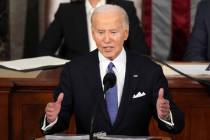LETTERS: If monorail went to airport, money and more visitors would follow
The recent comment by Curtis Myles, president of the Las Vegas Monorail, that it is too expensive to connect the monorail to the airport is about as logical as Yogi Berra’s line about a restaurant: “It’s so busy nobody goes there anymore” (“Monorail to McCarran? Still too expensive, executive says,” Saturday Review-Journal).
Las Vegas Convention and Visitors Authority surveys show that almost half of the 40 million visitors to Las Vegas come by air. Almost every major airport I have ever been to has a rail link from the airport to the city. I believe the Las Vegas Monorail has consistently lost money due in no small part to the lack of a direct connection to the airport.
But who are we kidding here? The reason there is no connection to the airport is because of the vested interests and political power of the ground transportation companies that serve the airport and don’t want competition.
On a related matter, there have been three articles in the last couple of weeks referring to the 40 million visitors who annually come to Las Vegas, based on estimates from the LVCVA, using airport traffic and highway traffic counts at the state line. It is an estimate of “visitations” (total trips), not visitors (unique individuals). The reality is that all destinations have repeat visitors.
In the 2014 LVCVA Visitor Profile Survey, only 10 percent visited just once and as many as 16 percent visited more than 10 times during the year. The average was 6.9 times. If you divide the total visitation estimates by that number, you get an estimate of just under 6 million visitors — still a lot, but hardly 40 million. And when you make it easy for visitors to travel from the airport to a Strip hotel, where a large share of them stay, you encourage more frequent visitations and more new visitors. I think this is called good customer service.
David M. Zamarin
Henderson
Features section
I read with great dismay the article from Stephanie Grimes, the Review-Journal’s new features editor (“Changes offer more options to readers,” Nov. 9 Review-Journal). Her article is about what features are coming back and which ones are leaving the newspaper.
Ms. Grimes states that she is trying to make changes that benefit locals, yet she is cutting most reviews of community theaters, which accomplishes the opposite of what she purports to be doing for locals. She talks about making the best use of the R-J’s resources. It seems to me that those resources are declining. The R-J should be growing in size, with features that attract more readers, but sadly, each day the paper gets lighter and lighter.
This makes me ask how much longer I want to subscribe to a paper continually losing content.
William H. Isaac II
Henderson
Test scores and ESAs
Last week, math and reading test scores for students nationwide were released, and Nevada students’ scores were flat and below the national average (“Nevada students trail nation in math, reading,” Oct. 27 Review-Journal online). The National Assessment of Educational Progress found only 29 percent of Nevada fourth-graders were proficient in reading, only 32 percent were proficient in math, and only 27 percent of eighth-graders were proficient in reading and 26 percent in math.
These scores should shock every Nevada parent, and they help explain why more than 3,000 applications for Nevada’s new Education Savings Accounts have already been submitted to the state treasurer. This is exactly the reason why the ESA program was designed — to help families trapped in the traditional public school system, giving their children needed alternatives.
Recent analysis of the applications found the program is helping some of the state’s most disadvantaged families; at least 21 percent of the applicants are from families earning less than $44,863 a year (“Most school-choice program applicants from wealthy areas,” Nov. 1 Review-Journal). This figure is promising if we consider the many challenges that low-income families face, including lack of access to information, limited access to technology and linguistic isolation. Their response is encouraging, especially in light of the recent NAEP scores.
The status quo is failing too many children, and until Nevada’s school choice programs were passed, economically disadvantaged families lacked the resources to access alternative educational options. While critics of school choice continue to try to legally and politically undermine the program, the evidence is clear that it is working as intended. And, as the NAEP scores demonstrate, fighting to keep kids trapped in schools that fail to meet their needs just doesn’t add up.
Hergit Llenas
Las Vegas


















